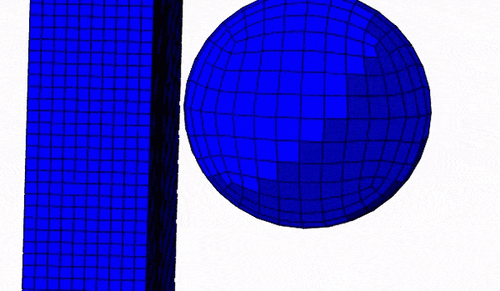This article focuses on our experience gained in FEA consultancy, practical testing and validation. What issues did we experience and how did Simuleon address those challenges? Due to existing NDA’s and sensitivity of customer names, an anonymous case is described.
The Challenge
As with most of the projects we do, there is always a clear reason why customers ask us to perform a simulation. In this project it is all about setting up a simulation which describes a practical to raise the predictability for the customer in order to do a later redesign based on this knowledge. So the main question in this challenge was:
“Set-up and run a Finite Element Analysis that captures the behaviour of existing product X, and discover potential areas for future improvements in a redesign”.
How Do We Approach This?
Most of the time, our customers appreciate the project being offered at fixed price, so usually we spend quite some time in the feasibility of projects. During this feasibility study, we ask the customer to provide us with the necessary information such as the 3D CAD geometry, material specifications, boundary conditions, loading applications, areas of interest, and necessary output from the simulations. And of course it is very important to know the why behind their main question. Based on the information that is given, we determine a lot of things to eventually come to an offer. A few of the questions to perform our internal feasibility are:
- What modelling approach to take?
- Do we have sufficient information?
- What is missing?
- What is the quality of the 3D CAD Geometry?
- How much could we simplify?
- Contacts
- Loads
- Boundary conditions
- etc
- How much time is needed to model the approach?
- What are the costs?
- What is the throughput time?
- And many more….
The Given Information for This Case
In this case we received 3D-CAD geometry, a datasheet with the material conditions, the boundary conditions and loading by the customer. As in a lot of the cases, a possible plastic behaviour in this model was likely, while the simplified datasheet did not describe the typical behaviour beyond yield stress. Since the material used was a quite common metal, a stress-strain curve was provided later on by the customer based on our additional request.
Sometimes our customers have the ability to do a tensile test themselves, but in most of the cases they don’t have this ability and rely on their material supplier to provide them with a stress-strain curve for that given material at a given temperature. Please be aware that most of the datasheets provided by suppliers are for a given temperature (room temperature at 20 degrees Celcius). If your supplier does not have such information or doesn’t want to provide that, arranging a practical tensile test, compression test, bending test, Charpy test, etc can be necessary.
What Was Not Shared With Us Initially?
Unfortunately the customer did not initially give us the practical end-values of the physical test for product X . Their reason behind that, was to test how close our solution would be, before sharing the practical results with us. Probably this has to do with the idea that we would tailor our results to get close to that practical value. We will get back to this later on, but at that moment in time we did not get the practical values.
Our First Explorations
In our approach we initially took a solid modelling approach which was quite untraditional for the given geometry. The reason behind that was clear: there was only a limited amount of budget which did not allow us to remodel the geometry or set-up a mid-surface model, and the complexity of the given geometry was enormous. So during our first explorations we gained a fist draft result. Soon we noticed internally that the draft result was heavily depending on the mesh coarseness, so we performed a mesh sensitivity study to determine for which given mesh size both displacement and stress seemed stable. That value for the stable situation was communicated with the customer, and as you would expect from the title of this article, unfortunately our values were not even close to the values of the physical tests.
Results Were Off, How to Continue?
Even though we seemed to have a stable converged situation for the displacements and stress values, our untraditional solid modelling approach made us doubt that maybe some unexpected behaviour was going on, which could not be covered correctly in this solid mesh approach. Even though we had a minimum of x number of elements over the bending cross-section, the results were off.
So on our own initiative we have set-up a surface model to get rid of the bending stiffness assumptions that are applied by selecting a solid mesh. As I told you earlier, the complexity of the model was enormous, so setting–up a surface model was not that straight forward. It took quite some time and manual clicking, stretching and trimming to have a running mid-surface model which still represents the solid geometry. Eventually we succeeded and had produced a faster running Finite Element Analysis model.
Luckily the displacements and stresses for the shell model were really close to the values of our first solid mesh model. So our doubt regarding our untraditional approach was gone, but the values were still consistently off for both cases.
Can We Please Have the Results From the Practical Test?
Since we still had not found the solution to why the results were off, we asked for the values of the practical test. Luckily we got those, but as you can imagine, that did not bring us further at that moment in time. So we knew the values now, but we did not know why they were deviating like that.
If we would have got the practical test values earlier in the project, it would have spared quite some time with the investigation. Instead of knowing if our value is correct yes / no, we could have seen if our value is higher or lower compared to practice. When the displacement for instance, is higher in practice than it is in the FEA model, that could potentially show that your model is over stiffened somewhere. If the displacement is lower in practice than it is in the FEA model, that could indicate the there is too much flexibility due to lack of contacts and penetration. At least that would have given a direction earlier in the project where to search for the difference.
What Else Can We Double Check?
Of course we did all the necessary double checks. Did we apply the loading to what the customer provided us? Did we apply the given boundary conditions correctly? Did we pick the correct material model to correctly capture the plasticity behaviour? Did we use the correct given material specifications? Etc. The answer to the questions above were all; “Yes we applied everything as provided to us.”
Could We Join to See the Practical Test?
This seemed to be the only way, to have a better idea of what could possibly be different in practice compared to the assumptions in our FEA calculations, so we joined for the test. During the test we saw how the loading was applied, and based on the loading, nothing was showing strange or different behaviour compared to our Simulation model.
We noticed that there seemed to be a small difference for the boundary conditions in reality, compared to what was given by the customer and applied to our FEA model. That was the only noticeable difference that we could experience during the practical tests.
Remodelling the Applied Boundary Conditions From the Practical Situation
Based on what we had seen, we translated our experiences to the existing FEA model, and reran the simulation with the new boundary conditions. The results were finally within 1.2% of deviation compared to the practical values, which was a really good achievement. It really surprised us how a seemingly small difference in boundary conditions change the end results a lot, luckily in the right direction.
What Have We Learned?
In this particular situation it is quite clear that we have spent way more time than necessary and calculated for this project. Luckily we found the solution at the end and have a simulation model running that is able to describe the behaviour of the practical test accurately and realistic. Looking back, what should we have done differently?
- Discuss all given information like boundary conditions and loads, and find out why they are like that, as provided to you
- Receive practical test values in the beginning of your project as soon deviation occurs
- Gain confidence of your current approach with different FEA model approaches
- Make sure your mesh sensitivity study covers the correct bandwidth
- Always try to validate your simulation results with a practical test
So basically we have learned that we always need to discuss the given boundaries. The given information was quite clear from the beginning, and there was actually no reason based on our experiences to doubt the given boundary conditions and assumptions, but we should have done that anyway, and we will do that in the future.

 Advanced Simulation
Advanced Simulation


